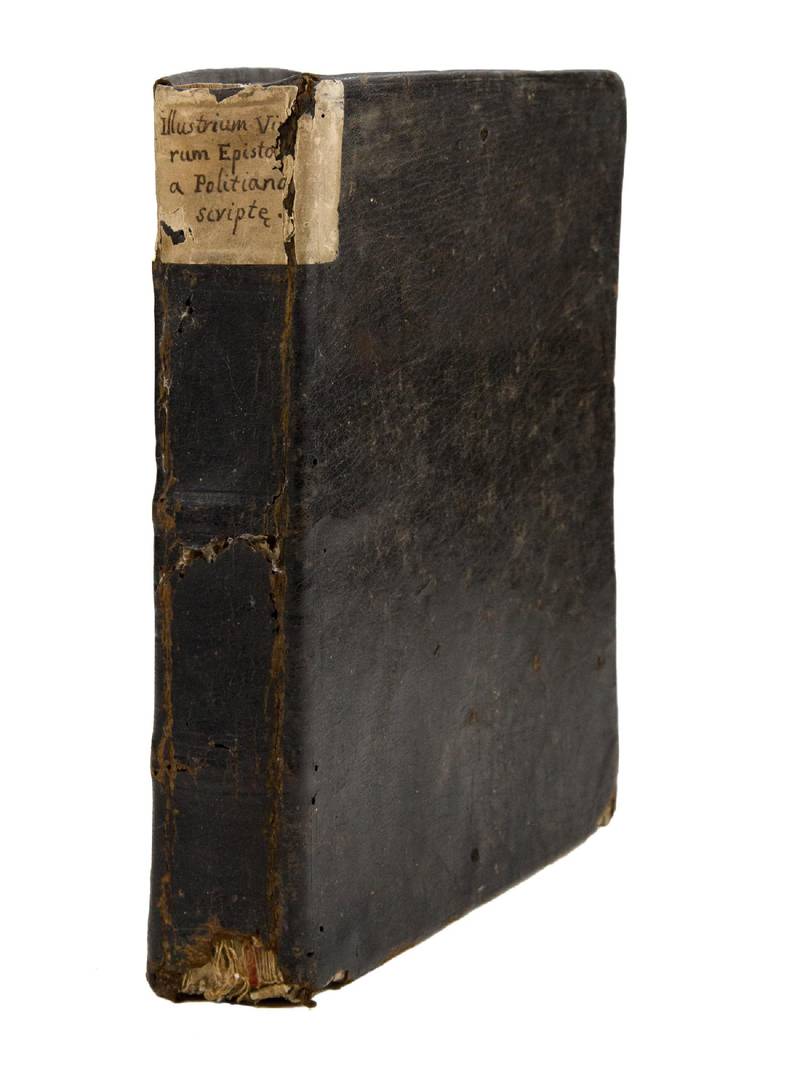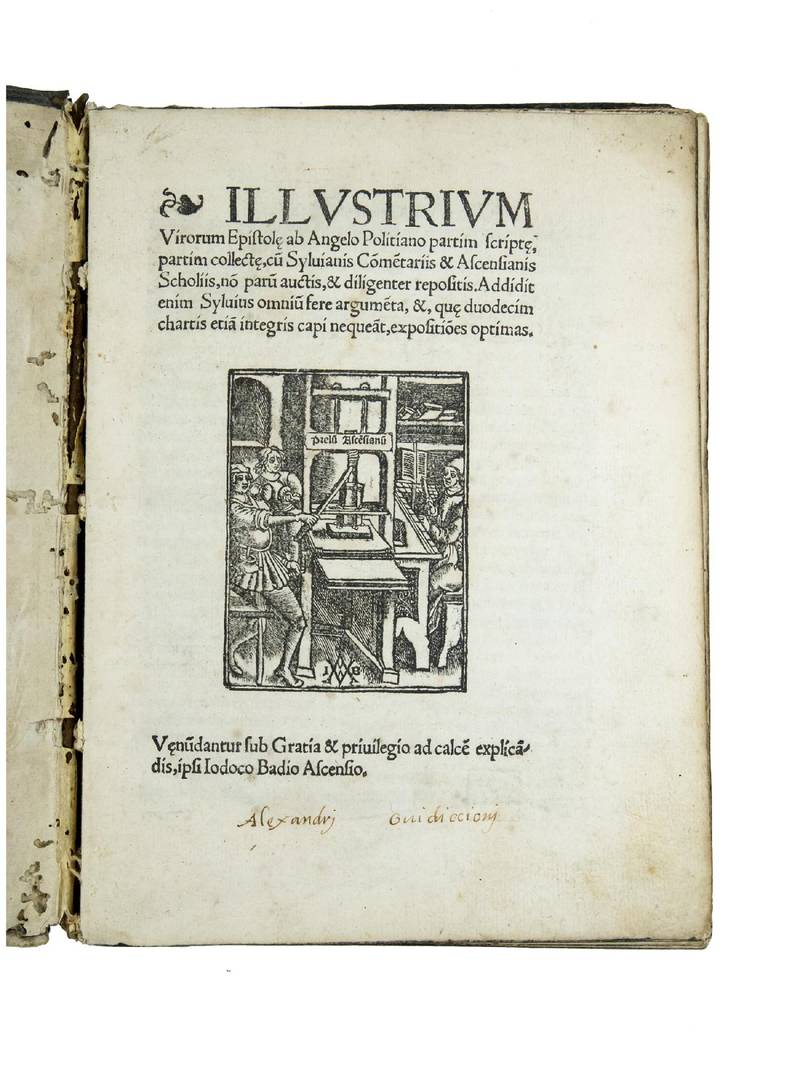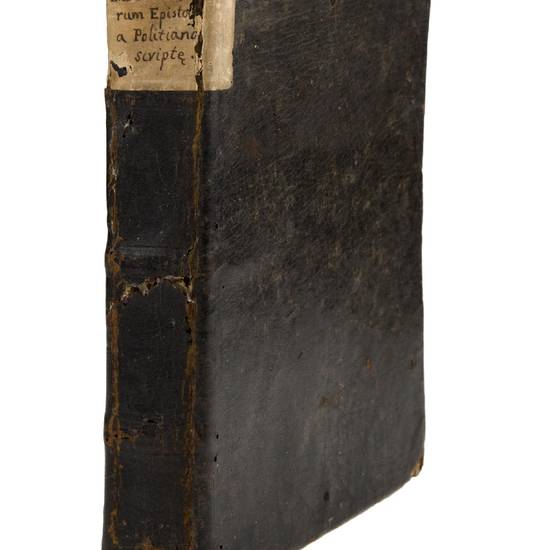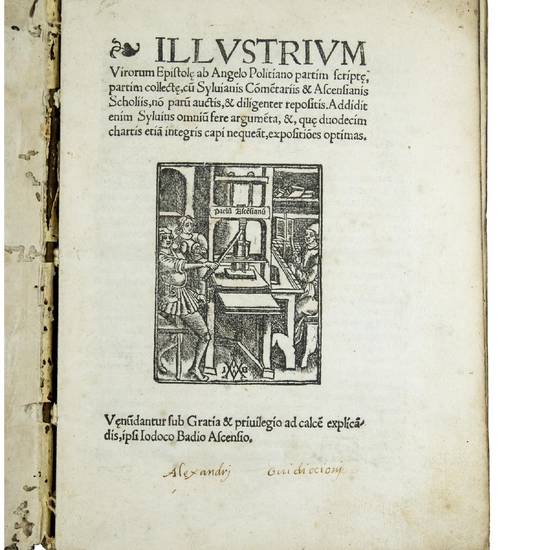Illustrium Virorum Epistolae ab Angelo Politiano partim scriptae, partim collectae, cum Sylvianis Commentariis & Ascensianis Scholiis, non parum auctis, & diligenter repositis. Addidit enim Sylvius omnium fere argumenta, & quae duodecim chartis etiam integris capi nequeant, expositiones optimas
Autore: POLIZIANO, Angelo (1454-1494)
Tipografo: Josse Bade
Dati tipografici: Paris, 1520
Large 8vo. (8), CCLXXXVI leaves. AA8, a-z8, A-M8, N6. With the printer's device on the title-page. Contemporary calf, blind-stamped fillets on the panels, with the entry of ownership of Alessandro Guidiccioni (1524-1605), bishop of Lucca, on the title-page.
Guedet, p. 644; Martín Baños, p. 669; Ph. Renouard, Bibliographie des impressions et des oeuvres de Josse Bade, (Paris, 1908), I, p. 184, no. 5.
SECOND EDITION with the commentary by François Dubois but first to contain a new dedication letter by him to pope Leo X, dated from Paris, Collège de Boncourt, May 18, 1520. When in July 1498 the Venetian press of Aldo Manuzio produced an edition of Poliziano's collected Latin and Greek works, also 251 letters, divided in twelve books, were included (mostly by Poliziano himself, but also some addressed to him and some exchanged between his correspondents). Poliziano certainly had hand in preparing his works for print before his death, but Alessandro Sarti, a friend, and Pietro Crinito, a pupil, did the actual editing. These letters alone were re-published under the title Illustrium virorum epistolae at Lyon in 1499 by Josse Bade, and again in Paris in 1510 and 1515, in Antwerp in 1510, and in Strasbourg in 1513. In 1517 Bade published a new edition with the commentary by François Dubois.
“By 1517 Poliziano's collection had demonstrably acquired the status of a textbook. In that year, Josse Bade, from his Paris press, started a profitable run of printings of the letters, edited with extensive commentary by François Du Bois, Du Bois had published the first two centuries of his Progymnasmata in the previous year. His annotations to Poliziano's Illustrium virorum epistolae must therefore have emerged from the same environment at the Collège de Montaigu, although we know that he was at the Collège de Lisieux by the end of 1517 (at the Collège de Boncourt between 1520 and 1526, and at the Collège de Tournai subsequently). The commentaries appended to each of the letters (and supplemented by a few extra notes by Josse Bade) tell where Du Bois focused his students' attention [...] Du Bois' attitude to the Latin language question is implicit and subtends his annotation. His commentary is an example of the grammatical exercise enarratio, exactly the same kind of commentary that humanists appended to their editions of Latin authors. Such commentaries were in effect classroom lecture notes. They were generally tidied up and expanded for publication, but they certainly reproduced the instruction that was given and the manner in which it was transmitted orally, point by separate point, following the order of the text studied, and by no means necessarily pausing to reflect on the thrust of the work taken as a whole (that was the matter for an introductory general lecture, a praelectio, if there was one). Once problems of verbal and syntactic comprehensions had been covered (lectio), the purpose of enarratio was to explain people and places, to fill out passing allusions by extensive quotation from apposite classical texts, in short to contextualize the work studied within the ancient culture from which it drew its language, its frame of reference, and its intellectual concepts” (A. Moss, Renaissance Truth and the Latin Language Turn, Oxford, 2003, pp. 74-75; see also A. Campana, Per il carteggio del Poliziano, in: “La Rinascita”, 6, 1943, pp. 437-472; M. Martelli, Il ‘libro delle Epistolae' di Angelo Poliziano, in: “Interpres”, 1, 1978, pp. 184-255; and F. La Brasca, La correspondence d'Ange Politien (1454-1494). La lettre (en)volée ou comment on fabrique un recueil épistolaire, in: “Epistulae antiquae. Actes du premier colloque: Le genre épistolaire antique et ses prolongements, Tours, 1998”, L. Nadjo & E. Gavoille, eds., Louvain, 2002, II, pp. 387-406).
Collections of Poliziano's letters were reprinted again and again until the middle of the 17th century, alone or with letters by some of his fellow humanists as Francesco Filelfo, not only for his commentaries on classical texts, or historical contents, but also as eminent models of an elegant Latin style. His correspondence also gives us an intimate glimpse of the revival of classical literature from the pen of a man at the very center of the Renaissance movement, and also illuminates his close friendship with the philosopher Pico della Mirandola. Besides part of correspondence concerns the composition and reception of his Miscellanies, a revolutionary work of philology. Among his other correspondents were Piero de' Medici, Niccolò Leoniceno, Filippo Beroaldo, Pomponio Leto, Ermolao Barbaro, Battista Guarini, Marcantonio Sabellico, and many other scholars of the time.
François Dubois (Franciscus Sylvius, ca. 1483-1536), a native of Amiens, taught humanities in various Parisian colleges, and became the principal of the Collège de Tournai in 1527. From about 1516 Dubois was one of the team of scholars assisting Bade with his editions of the classics. He also published a widely used textbook on rhetoric, and later specialized in editions of Cicero's Orationes. In all his efforts he proved a serious but not exceptionally talented scholar. However, Erasmus, who had met him in Louvain in 1519, had a high opinion of him.
Josse Bade (c. 1461-1535), or more commonly, Jodocus Badius Ascensius, enjoys the reputation of one of the greatest printers of his time, and especially that of one of the chosen publishers of Erasmus, at least until the latter definitively cast his lot with Froben of Basle in 1517. He was born in the Flemish town of Asche near Brussels and made his first studies with the Jeromites of Gand, a school of the Brothers of Common Life. He continued his studies in Italy first at Ferrara under Battista Guarino and then at Mantua under Filippo Beroaldo. After his return from Italy he taught for a while at Valence and then learned the art of printing from Johann Trechsel in Lyon, soon assuming the literary direction of the firm. After Trechsel's death in 1498, he left Lyon. In Paris he founded in 1503 his own press the Praelum Ascensianum, using the representation of a printing press as his device. Over two-hundred and fifty works were issued from his press: authors of pagan and Christian antiquity, of the Middle Ages, and of his time, as well as his own works in such areas as grammar, history, philosophy, law, and literature. He married his four daughters to printers, among them Jean de Roigny, Michel Vascosan, and Robert Estienne. Upon Badius's death his Praelum Ascensianum was merged with the Estienne Press (cf. M. Lebel, Josse Bade, éditeur et préfacier, in: “Renaissance and Reformation”, n.s., 5/2, 1981, pp. 63-71).
Angelo Poliziano, whose birth name was Angelo Ambrogini, derived his surname from his native town (Mons Politianus, Montepulciano). His mother, Antonia Salimbeni, belonged to a prominent Florentine family, and his father Benedetto was a doctor of law and held a number of public offices in Montepulciano and elsewhere. Angelo soon came under the protection of Lorenzo de' Medici and at ten went to Florence to study Latin and Greek, and quickly distinguished himself as a prodigy. At thirteen he began to circulate letters in Latin; at sixteen he translated Books II-V of the Iliad into Latin hexameters; at seventeen he was versifying in Greek; at eighteen he published an edition of Catullus.
All this brilliance attracted the attention of Lorenzo de' Medici, the autocrat of Florence and the chief patron of learning in Italy, who took Poliziano into his household, made him the tutor of his children, and secured for him a professorship at the University of Florence. This remained his situation to the end of his life, a quiet one in which he trained students from Italy, but also from Germany, England, and Portugal, in this way influencing scholars from one end of Europe to the other. For a still wider public he published the notes of his courses on Ovid, Svetonius, Statius, Pliny the Younger, and Quintilian. His work on the Pandects of Justinian I, though not of high rank as a work of erudition, stimulated the wider study of Roman law. His fluency as a poet and translator was an important part of his effectiveness. He used his own didactic poem Manto, a panegyric of Vergil, to introduce his course on Vergil. His Latin versions of some of the Greek classics, including Hippocrates and Galen as well as Plato's Charmides, were highly regarded at the time, as was a collection of Tuscan songs based on various forms of popular poetry (his patron Lorenzo was concerned to revitalized Tuscan culture).
Poliziano's Italian opera Orfeo was performed at Mantua. He was an important figure in the line of development of Italian poetry, leading a generation later to Ariosto. Here also he represents a stage beyond that of Valla, and further toward the emergence of the European local languages (cf. I. Maïer, Ange Politien. La formation d'un poète humaniste (1469-1480), Genève, 1966, passim; see also P. Godman, From Poliziano to Machiavelli. Florentine Humanism in the high Renaissance, Princeton, NJ, 1998, passim; and V. Fera & M. Martelli, eds., Agnolo Poliziano, poeta, scrittore, filologo. Atti del Convegno Internazionale di Studi, Montepulciano, 3-6 novembre 1994, Firenze, 1998, passim).
It is likely that Politian had homosexual penchants. He is said to have had male lovers, and he never married. Evidence also includes denunciations of sodomy made to the Florentine authorities, poems and letters of contemporaries, allusions within his work (most notably Orfeo), and the circumstances of his death. The last suggests he was killed by a fever (possibly resulting from syphilis) which was exacerbated by standing under the windowsill of a boy he was infatuated with despite being ill. Some also pretend that he has been a lover of Pico della Mirandola (cf. C. Dionisotti, Considerazioni sulla morte del Poliziano, in: “Culture et société en Italie: du Moyen Âge à la Reinassance”, Paris, 1985, pp. 145-156).
However, in 2007 the bodies of Poliziano and Pico were exhumed from St. Mark's Basilica in Florence. Scientists under the supervision of Giorgio Gruppioni, a professor of anthropology from Bologna used current testing techniques to study the men's remains and establish the causes of their deaths. A TV documentary was made of this research, and it was recently announced that these forensic tests showed that both Poliziano and Pico della Mirandola likely died of arsenic poisoning. The chief suspect is Piero de' Medici, the successor of Lorenzo, but there are others involved (cf. M. Moore, Medici philosopher's mysterious death is solved, in: “The Daily Telegraph”, February 7, 2008).
Poliziano appeared twice in the frescoes of the great Florentine artist Domenico Ghirlandaio. First in the Confirmation of the Rule (1482-1485, Santa Trinità, Florence) as tutor of Lorenzo de' Medici's sons, and then in The Annunciation of the Angel to Zaccharia (1486-1490, Santa Maria Novella, Florence), here together with his fellow humanists Marsilio Ficino, Cristoforo Landino, and Demetrius Chalcondyles.
For a detailed list of all the letters printed in the present volume see http.//www.uni-mannheim.de/mateo/itali/autoren/politianus_itali.html.
[9060]





